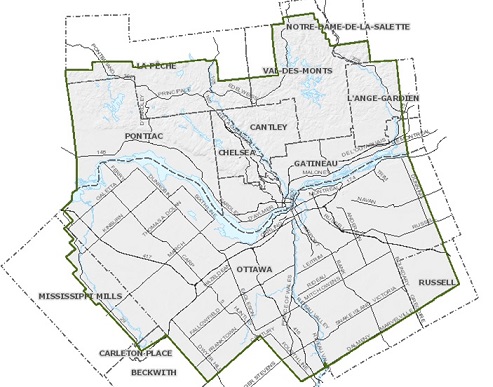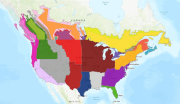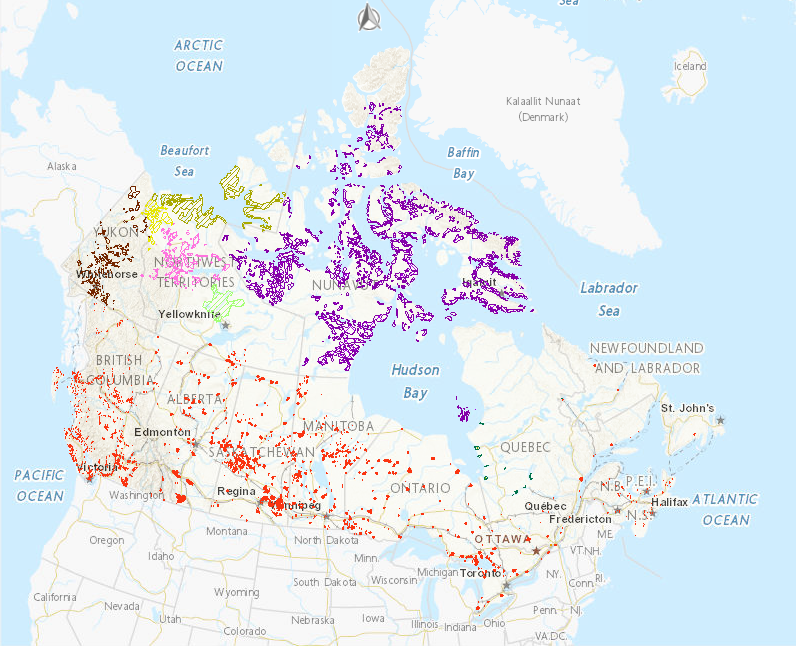Frontière
Type of resources
Available actions
Keywords
Contact for the resource
Provided by
Years
Formats
Representation types
Update frequencies
status
Service types
Scale
-

This map presents the history of the political boundaries in Canada, from Confederation in 1867 to 2017. Canada’s boundaries are dynamic political structures that reflect the changing political, economic, and cultural conditions of the country through time. Canada’s long and diversified settlement history is reflected in the two distinct patterns of boundaries that differentiate eastern and western Canada. In the east, the evolution of the Atlantic provinces’ boundaries are the outcome of 200 years of colonial competition for both land and resources. Similarly, Quebec and Ontario grew from frontier settlements to industrialized economies between 1760 and the early 1900s. As well, in the boundaries of eastern Canada closely conform to natural features such as drainage basins. In contrast, the boundaries of western and northern Canada reflect the administrative organization of these lands by, first, the Hudson’s Bay Company and, later, the Government of Canada. Here, geometric lines radiate northward from the 49th parallel, creating boundaries that often divide communities and regions into two different provincial jurisdictions. Each of the western provinces has a unique history and rationale for their boundaries. Manitoba evolved from the first Riel Rebellion as a "postage stamp" province, and only later achieved its present-day boundaries. Alberta and Saskatchewan earned provincial status with an eye to creating equal land areas. On the Pacific coast, the British colonies had to act quickly in response to the explosive gold mining frontier to organize and solidify their territorial claims to present-day British Columbia, and later to help establish the Yukon Territory in response to American encroachment. In the North, the boundaries of the existing Territories were redrawn in 1999 to create Nunavut. The boundaries of this new territory respect the traditional Aboriginal concept of territoriality. This online interactive map relies on the emerging "MapML" standard co-developed by Natural Resources Canada. The objective of this evolving standard is to make it simple for beginners and experts alike to create maps in Web pages that use open data and map services.
-
The National Parks and National Park Reserves of Canada Legislative Boundaries web service includes the following lands: 1) National Parks of Canada as defined in Schedule 1 of the Canada National Parks Act, 2) National Park Reserves of Canada as defined in Schedule 2 of the Canada National Parks Act, 3) Rouge National Urban Park as defined in the Rouge National Urban Park Act and 4) Saguenay–St. Lawrence Marine Park as defined in the Saguenay-St. Lawrence Marine Park Act. The Data available for download is the former National Framework Canada Lands Administrative Boundaries Level 1 product. There are some attribute differences between the data available for download and the web service; however both contain the same underlying data. Please refer to the Supporting Documents for additional information on the National Framework Canada Lands Administrative Boundaries Level 1 dataset. Work is under way to align these two data products. As well, the Comprehensive Claims Settlement Areas have been removed from this dataset, but can be obtained from the Post-1975 Treaties (Modern Treaties) dataset produced by Indigenous and Northern Affairs Canada.
-

Boundaries of the National Capital Region since 1959, with the coming into force of the National Capital Act
-

The Environmental Studies Research Fund (ESRF) Regions are legally described in Part I and Part II of the Schedule in the Environmental Studies Research Fund Regions Regulations in the Canada Petroleum Resources Act. This data collection is for illustrative purposes only and includes: • 1 dataset illustrating ESRF prescribed regions 1 to 31 as they are described in the ESRF Regions Regulations. • 1 dataset illustrating the areas where levies are no longer applied to ESRF prescribed regions. These areas include lands that are described in the ESRF Regions Regulations but have since been devolved to the Government of Yukon or the Government of Northwest Territories as part of the 2003 Yukon Devolution and 2014 Northwest Territories Devolution, respectively. Once the Yukon Act and Northwest Territories Act came into effect, lands subject to devolution were no longer considered frontier lands or Canada lands, and therefore no longer subject to ESRF levies under the Canada Petroleum Resources Act. The geospatial extents used in this dataset represent those identified in the Devolution Agreements. Future updates to Part II, section 3 of the Schedule in the ESRF Regions Regulations will reflect the Yukon and Northwest Territories Devolutions. • 3 maps (National, North, South). • 1 table compiling the historical levies for each ESRF prescribed region. Context: The Environmental Studies Research Fund (ESRF) is a research program which sponsors environmental and social studies designed to assist in the decision-making process related to oil and gas exploration and development on Canada's frontier lands. The ESRF is directed by a 12-member Management Board which includes representation from the federal government, the Canada-Newfoundland and Labrador Offshore Petroleum Board (C-NLOPB), the Canada-Nova Scotia Offshore Energy Regulator (CNSOER), the oil and gas industry, and the public. The ESRF is administered by a secretariat which resides in the Offshore Management Division in Natural Resources Canada. Since 1987, the ESRF has received its legislative mandate through the Canada Petroleum Resources Act. The ESRF regions are described in the Environmental Studies Research Fund Regions Regulations. As well, the Canada-Newfoundland and Labrador Atlantic Accord Implementation Act and the Canada–Nova Scotia Offshore Petroleum Resources Accord Implementation and Offshore Renewable Energy Management Act provide legislative direction in the southern ESRF regions. Funding for ESRF is collected annually through levies paid by lease-holding oil and gas companies active in a specific ESRF region. In accordance with the legislation, levies are recommended by the Management Board to the Ministers of Natural Resources and Crown-Indigenous Relations and Northern Affairs for approval. Levies in the southern regions in areas governed by an offshore Accord are subject to final approval by the respective offshore regulator (i.e., the C-NLOPB, or the CNSOER). Levies are calculated by multiplying the levy rate of a region by the number of hectares of land under lease. The ESRF has sponsored studies on biodiversity; environmental effects and monitoring; social and economic issues; ice, icebergs, and ice detection; oil spill research and countermeasures; sea bottom ice scour; sediment transport; Indigenous Knowledge; and waves.
-
Cartographic representations of Fisheries Management Areas (FMA)s in the Atlantic and Arctic Regions. Currently Published Fisheries Management Areas: Capelin Crab Herring Mackerel Salmon, Atlantic Scallop Shrimp Snow Crab Squid Each polygon feature class delineates the coordinates of a different series of FMAs. Shapes have been drafted based on a combination of sources including: the Atlantic Fisheries Regulations, Integrated Fisheries Management Plans, indigenous treaties, the bounds of the Territorial Sea, and other information made public on Fisheries and Oceans websites. Information from Variation orders and Conditions of License were also incorporated. The specific sources used to construct each feature class is listed in its metadata and direct links to public sources are included. The original documentation uses a diverse combination datums, or include coordinates with no listed datum. This data series has been projected into NAD83. Vertices in this dataset may differ from the original source documents to fix slivers, make areas congruent with coastlines, or align with other administrative boundaries. Changes made to the original areas in order to make drafting possible have been highlighted in the comments field in the attribute tables. Lines were first drafted as geodesics and vertices were added to approximate loxodromes using the Construct Geodesic Tool in ArcGIS Pro 2.9.8. As documentation is drafted, additional FMAs will be added to the dataset. Currently drafted FMAs my change and expand into currently unmapped areas as new information is incorporated. The feature classes produced as a part of this data series are cartographic representations of legal documents and are meant to be used for general reference in support of marine planning. Whenever there is a difference between the original written source documentation and this digital representation, the originals should be considered authoritative. Every effort has been made to ensure that these files are as accurate as possible but these feature classes are not intended to be used for navigation, legal interpretation or enforcement.
-

The Canadian major and minor crop field trial regions were developed following extensive stakeholder consultation and have been harmonized between the Pest Management Regulatory Agency (PMRA) and the Environmental Protection Agency of the USA. The Canadian major and minor crop field trial regions were delineated, using the geographic information system (GIS) data processing hardware and software facilities in Spatial Analysis and Geomatics Applications (SAGA), Agriculture Division, Statistics Canada. In general, the delineation process involved integration, evaluation and reference to numerous geographic data sources in a GIS to determine the best sources for the delineation. There are seven major and four minor field trial regions. Each of these regions recognizes physical characteristics, such as soils, and crops and climate, that make the region unique within the Canadian agricultural landscape. The subzones address differences within a region, generally reflected in the types of crops grown in that region. The Canadian regions, as much as possible, correspond to the U.S. regions
-

The Aboriginal Lands of Canada Legislative Boundaries web service includes legislative boundaries of Indian Reserves, Land Claim Settlement Lands (lands created under Comprehensive Land Claims Process that do not or will not have Indian Reserve status under the Indian Act) and Indian Lands. More specifically it includes the following lands: 1) Indian Reserves that include: 1.1) surrendered lands or a reserve, as defined in the Indian Act (this definition excludes Indian Settlements and Indian Communities); and 1.2) Sechelt lands, as defined in the Sechelt Indian Band Self-Government Act, chapter 27 of the Statutes of Canada, 1986; 2) Land Claim Settlement Lands that include: 2.1) Category IA land or Category IA-N land, as defined in the Cree-Naskapi (of Quebec) Act, chapter 18 of the Statutes of Canada, 1984 (category 1B and category II Lands are excluded from this definition); 2.2) Settlement land, as defined in the Yukon First Nations Self-Government Act, and lands in which an interest is transferred or recognized under section 21 of that Act (only Yukon First Nations Settlement Lands, which were surveyed and the survey plan recorded, are included in the map service); 2.3) Inuit Owned Lands as defined in the Agreement between the Inuit of the Nunavut Settlement Area and Her Majesty the Queen in Right of Canada given effect and declared valid by the Nunavut Land Claims Agreement Act (it includes all parcels that have been surveyed and those that do not require a survey (this includes the islands)); 2.4) Gwich’in Lands as defined in the Gwich’in Comprehensive Land Claim Agreement, given effect and declared valid by the Gwich’in Land Claim Settlement Act; 2.5) Inuvialuit Lands as defined in the Western Arctic (Inuvialuit) Claims Settlement Act; 2.6) Sahtu Lands as defined in The Sahtu Dene and Métis Comprehensive Land Claim Agreement given effect and declared valid by the Sahtu Dene and Métis Land Claim Settlement Act; and 2.7) Tlicho lands, as defined in the Tlicho Agreement, given effect and declared valid by the Tlicho Land Claims and Self-Government Act; 3) Indian Lands that include: 3.1) Lands in the Kanesatake Mohawk interim land base, as defined in the Kanesatake Mohawk Interim Land Base Governance Act, other than the lands known as Doncaster Reserve No. 17. The data available for download is the former Geobase-Aboriginal Lands product. There are some attribute differences between the data available for download and the web service; however both contain the same underlying data. Please refer to the Supporting Documents for additional information on the Geobase - Aboriginal Lands dataset. Work is under way to align these two data products.
-
'Province' and 'territory' refer to the major political units of Canada. From a statistical point of view, province and territory are basic areas for which data are tabulated. Canada is divided into 10 provinces and 3 territories. Statistics Canada uses standard codes and abbreviations to represent provinces and territories. The two-digit code that uniquely identifies each province/territory is based on the Standard Geographical Classification (SGC). The code is assigned from east to west. The first digit represents the geographical region of Canada in which the province/territory is located and the second digit denotes one of the 10 provinces and 3 territories.
-

The following dataset correspond to the 230 m agricultural mask from Statistics Canada’s Crop Condition Assessment Program (CCAP). The mask have been generated from the classes 110 to 199 of the 2015 Agriculture and Agri-Food Canada’s landcover classification. The selection was then generalized to a spatial resolution of 230 m. The 2015 mask was used from the 2015 to the 2018 growing seasons inclusively.
-

The 2024 Census Subdivision Boundary File depicts the boundaries of all 5,028 census subdivisions, which combined, cover all of Canada. It contains the unique identifier (UID), name and type, as well as the UIDs, names and types (where applicable) of selected higher geographic levels. The 2024 Census Subdivision Boundary File is portrayed in Lambert conformal conic projection (North American Datum of 1983 [NAD83]) and is available as a national file.
 Arctic SDI catalogue
Arctic SDI catalogue